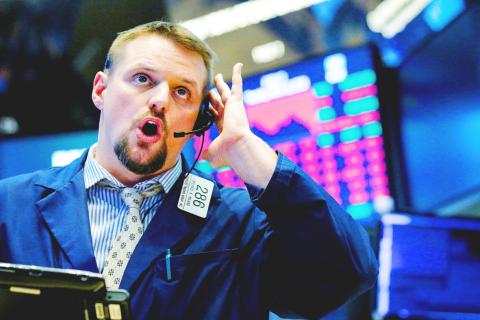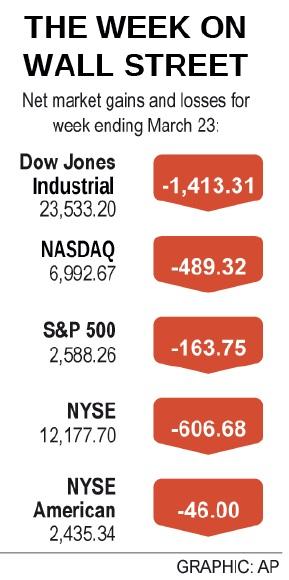Wall Street tumbled on Friday with more than 1,000 points knocked off the Dow Jones Industrial Average in two days as investors, increasingly nervous about a potential US trade war with China, shied away from risk ahead of the weekend and sought shelter from further losses.
In a volatile session, the S&P 500 came within a hair of its 200-day moving average, a key technical level. The benchmark index also nudged closer to its last month’s low, which marked a correction, ending 9.9 percent lower than its Jan. 26 record.
“There is concern what the trade war could look like. Investors want to manage their risk. If it escalates rapidly, it could be a major headwind for the market,” Global Markets Advisory Group senior market strategist Peter Kenny said in New York.

Photo: Reuters
US President Donald Trump’s plans for tariffs on up to US$60 billion in Chinese goods moved the world’s two largest economies closer to a trade war as China declared plans to levy duties on up to US$3 billion of US imports, including fruit and wine, even as it urged the US to “pull back from the brink.”
The Dow on Friday fell 424.69 points, or 1.77 percent, to 23,533.2, the S&P 500 lost 55.43 points, or 2.1 percent, to 2,588.26 after hitting an intraday low that was barely above its 200-day moving average of 2585.22.
The NASDAQ Composite dropped 174.01 points, or 2.43 percent, to 6,992.67.

For the week, the Dow was down 5.67 percent, the S&P 500 was down 5.95 percent and the NASDAQ was down 6.54 percent, marking their biggest weekly percentage falls since January 2016.
The Dow was down 11.6 percent since its Jan. 26 high and hit its lowest close since confirming a correction last month.
The Cboe Volatility Index, the most widely followed barometer of expected near-term volatility in the S&P 500, finished up 1.53 points at 24.87, its highest close since Feb. 13.
The S&P’s financial sector was the S&P’s biggest percentage loser, at 3 percent, after a volatile session in which it was whip-sawed by volatile US Treasury yields.
Bloomberg News cited the Chinese ambassador to the US saying that the country is “looking at all options” in response to tariffs, which could include scaling back purchases of US Treasuries.
NASDAQ was weighed down by declines in momentum stocks, such as Facebook Inc, Amazon.com Inc, Microsoft Corp and Google’s parent Alphabet Inc.
The semiconductor sector took a fall after Micron Technology Inc’s quarterly report stoked fears about falling NAND prices.
The Philadelphia Semiconductor index slumped 3.3 percent.
Declining issues outnumbered advancing ones on the New York Stock Exchange by a 3.96-to-1 ratio; on NASDAQ, a 3.72-to-1 ratio favored decliners.
The S&P 500 posted two new 52-week highs and 42 new lows; the NASDAQ Composite recorded 23 new highs and 93 new lows.
Volume on US exchanges was 8.11 billion shares, above the 7.3 billion average for the past 20 trading days.

Intel Corp chief executive officer Lip-Bu Tan (陳立武) is expected to meet with Taiwanese suppliers next month in conjunction with the opening of the Computex Taipei trade show, supply chain sources said on Monday. The visit, the first for Tan to Taiwan since assuming his new post last month, would be aimed at enhancing Intel’s ties with suppliers in Taiwan as he attempts to help turn around the struggling US chipmaker, the sources said. Tan is to hold a banquet to celebrate Intel’s 40-year presence in Taiwan before Computex opens on May 20 and invite dozens of Taiwanese suppliers to exchange views

Application-specific integrated circuit designer Faraday Technology Corp (智原) yesterday said that although revenue this quarter would decline 30 percent from last quarter, it retained its full-year forecast of revenue growth of 100 percent. The company attributed the quarterly drop to a slowdown in customers’ production of chips using Faraday’s advanced packaging technology. The company is still confident about its revenue growth this year, given its strong “design-win” — or the projects it won to help customers design their chips, Faraday president Steve Wang (王國雍) told an online earnings conference. “The design-win this year is better than we expected. We believe we will win

Chizuko Kimura has become the first female sushi chef in the world to win a Michelin star, fulfilling a promise she made to her dying husband to continue his legacy. The 54-year-old Japanese chef regained the Michelin star her late husband, Shunei Kimura, won three years ago for their Sushi Shunei restaurant in Paris. For Shunei Kimura, the star was a dream come true. However, the joy was short-lived. He died from cancer just three months later in June 2022. He was 65. The following year, the restaurant in the heart of Montmartre lost its star rating. Chizuko Kimura insisted that the new star is still down

While China’s leaders use their economic and political might to fight US President Donald Trump’s trade war “to the end,” its army of social media soldiers are embarking on a more humorous campaign online. Trump’s tariff blitz has seen Washington and Beijing impose eye-watering duties on imports from the other, fanning a standoff between the economic superpowers that has sparked global recession fears and sent markets into a tailspin. Trump says his policy is a response to years of being “ripped off” by other countries and aims to bring manufacturing to the US, forcing companies to employ US workers. However, China’s online warriors